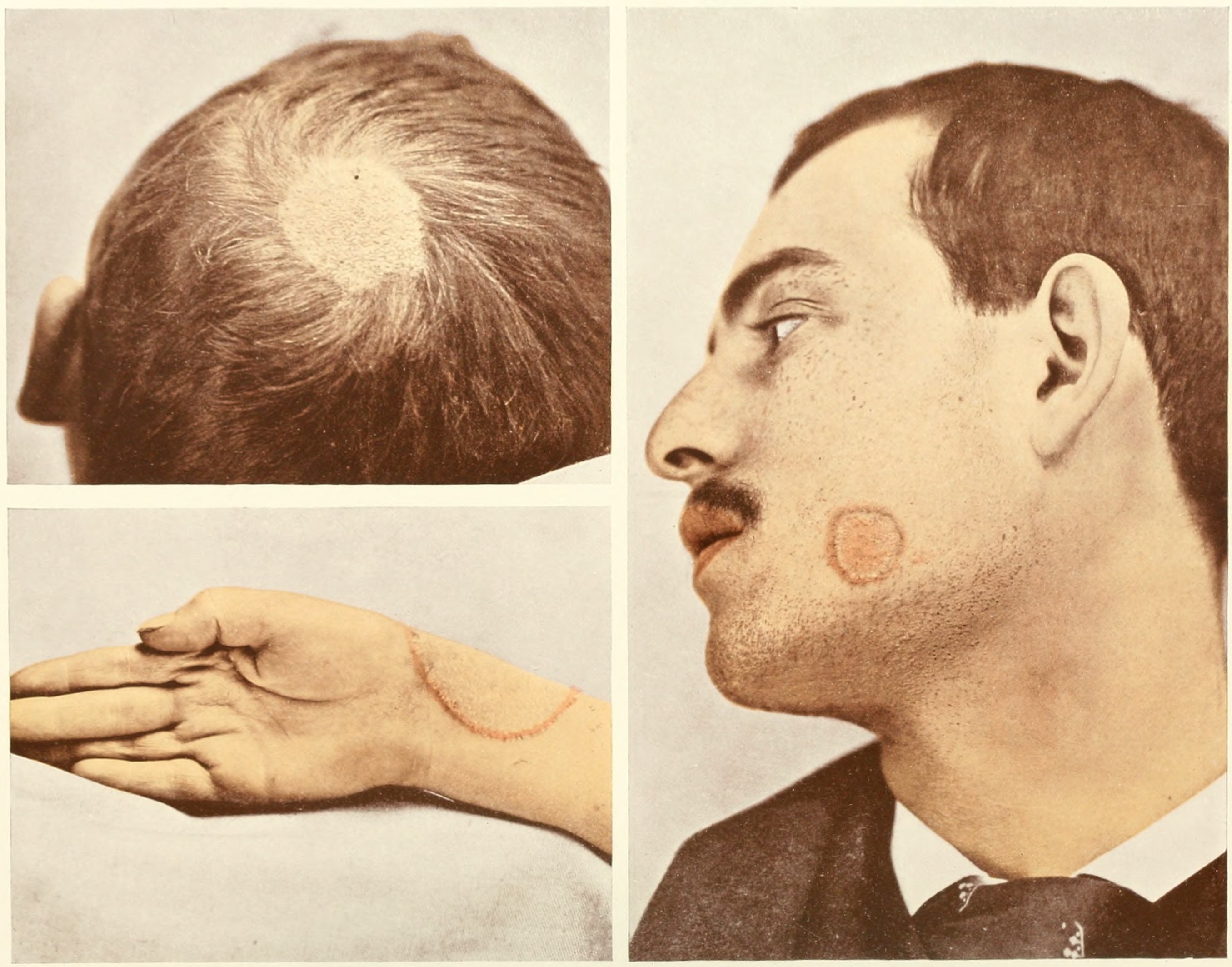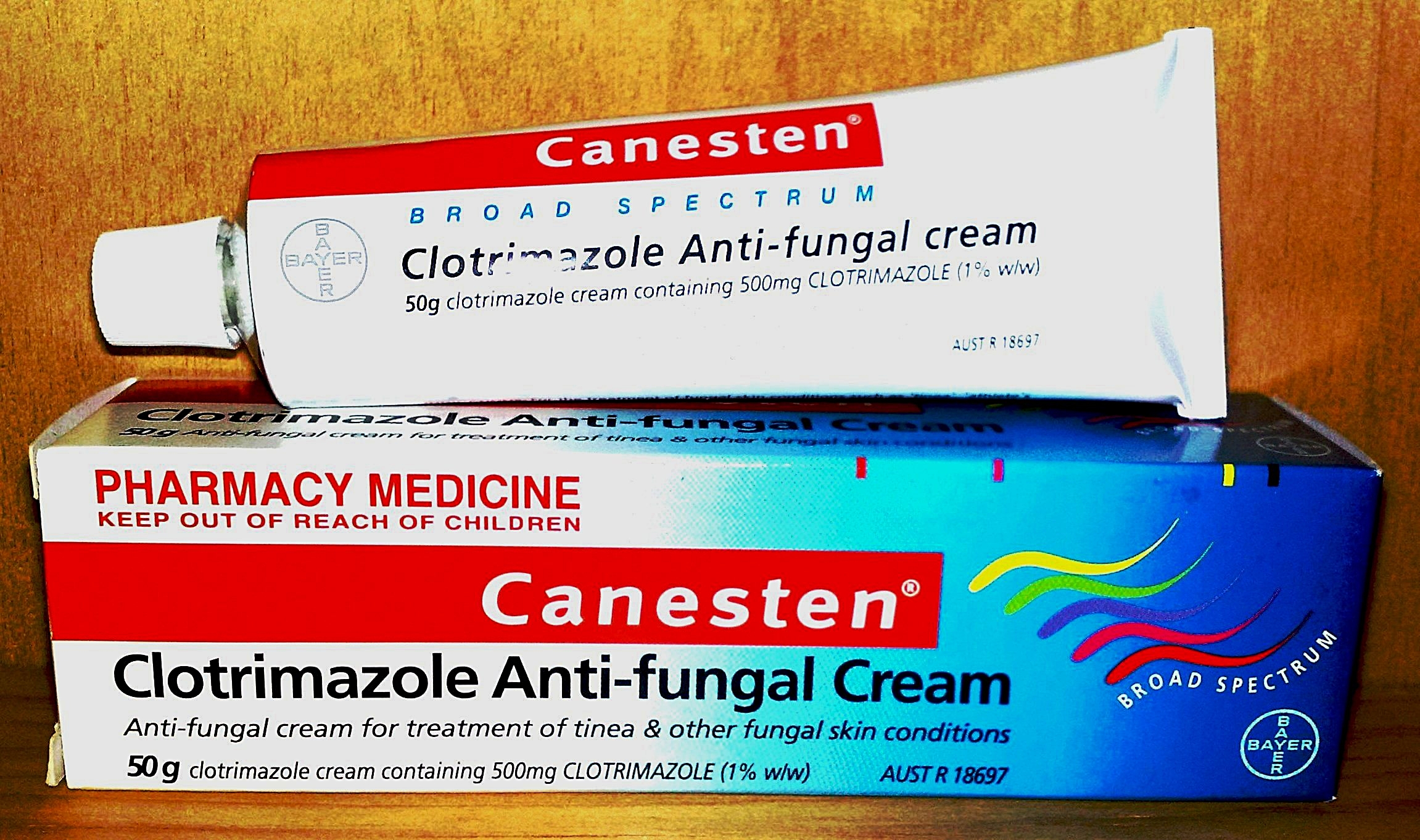|
Ringworm
Dermatophytosis, also known as tinea and ringworm, is a mycosis, fungal infection of the skin (a dermatomycosis), that may affect skin, hair, and nails. Typically it results in a red, itchy, scaly, circular rash. Hair loss may occur in the area affected. Symptoms begin four to fourteen days after exposure. The #Types, types of dermatophytosis are typically named for area of the body that they affect. Multiple areas can be affected at a given time. About 40 types of fungus can cause dermatophytosis. They are typically of the ''Trichophyton'', ''Microsporum'', or ''Epidermophyton'' type. Risk factors include using public showers, contact sports such as wrestling, excessive sweating, contact with animals, obesity, and immunosuppression, poor immune function. Ringworm can spread from other animals or between people. Diagnosis is often based on the appearance and symptoms. It may be confirmed by either microbial culture, culturing or looking at a skin scraping under a microscope. ... [...More Info...] [...Related Items...] OR: [Wikipedia] [Google] [Baidu] |
Tinea Unguium
Dermatophytosis, also known as tinea and ringworm, is a fungal infection of the skin (a dermatomycosis), that may affect skin, hair, and nails. Typically it results in a red, itchy, scaly, circular rash. Hair loss may occur in the area affected. Symptoms begin four to fourteen days after exposure. The types of dermatophytosis are typically named for area of the body that they affect. Multiple areas can be affected at a given time. About 40 types of fungus can cause dermatophytosis. They are typically of the '' Trichophyton'', '' Microsporum'', or '' Epidermophyton'' type. Risk factors include using public showers, contact sports such as wrestling, excessive sweating, contact with animals, obesity, and poor immune function. Ringworm can spread from other animals or between people. Diagnosis is often based on the appearance and symptoms. It may be confirmed by either culturing or looking at a skin scraping under a microscope. Prevention is by keeping the skin dry, not w ... [...More Info...] [...Related Items...] OR: [Wikipedia] [Google] [Baidu] |
Tinea Corporis
Tinea corporis is a fungal infection of the body, similar to other forms of tinea. Specifically, it is a type of dermatophytosis (or ringworm) that appears on the arms and legs, especially on glabrous skin; however, it may occur on any superficial part of the body. Signs and symptoms It may have a variety of appearances; most easily identifiable are the enlarging raised red rings with a central area of clearing (ringworm). The same appearances of ringworm may also occur on the scalp (tinea capitis), beard area ( tinea barbae) or the groin ( tinea cruris, known as jock itch or dhobi itch). Other classic features of tinea corporis include: * Itching occurs on infected area. * The edge of the rash appears elevated and is scaly to touch. * Sometimes the skin surrounding the rash may be dry and flaky. * Almost invariably, there will be hair loss in areas of the infection. Causes Tinea corporis is caused by a tiny fungus known as dermatophyte. These tiny organisms normally live on ... [...More Info...] [...Related Items...] OR: [Wikipedia] [Google] [Baidu] |
Athlete's Foot
Athlete's foot, known medically as ''tinea pedis'', is a common skin infection of the feet caused by a fungus. Signs and symptoms often include itching, scaling, cracking and redness. In rare cases the skin may blister. Athlete's foot fungus may infect any part of the foot, but most often grows between the toes. The next most common area is the bottom of the foot. The same fungus may also affect the nails or the hands. It is a member of the group of diseases known as '' tinea''. Athlete's foot is caused by a number of different funguses, including species of '' Trichophyton'', '' Epidermophyton'', and '' Microsporum''. The condition is typically acquired by coming into contact with infected skin, or fungus in the environment. Common places where the funguses can survive are around swimming pools and in locker rooms. They may also be spread from other animals. Usually diagnosis is made based on signs and symptoms; however, it can be confirmed either by culture or seeing hy ... [...More Info...] [...Related Items...] OR: [Wikipedia] [Google] [Baidu] |
Dermatophytes
Dermatophyte (from Greek '' derma'' "skin" ( GEN ''dermatos'') and ''phyton'' "plant") is a common label for a group of fungus of '' Arthrodermataceae'' that commonly causes skin disease in animals and humans. Traditionally, these anamorphic (asexual or imperfect fungi) mold genera are: '' Microsporum'', '' Epidermophyton'' and ''Trichophyton''. There are about 40 species in these three genera. Species capable of reproducing sexually belong in the teleomorphic genus Arthroderma, of the Ascomycota (see Teleomorph, anamorph and holomorph for more information on this type of fungal life cycle). As of 2019 a total of nine genera are identified and new phylogenetic taxonomy has been proposed. Dermatophytes cause infections of the skin, hair, and nails, obtaining nutrients from keratinized material. The organisms colonize the keratin tissues causing inflammation as the host responds to metabolic byproducts. Colonies of dermatophytes are usually restricted to the nonliving cornifie ... [...More Info...] [...Related Items...] OR: [Wikipedia] [Google] [Baidu] |
Clotrimazole
Clotrimazole, sold under the brand name Lotrimin, among others, is an antifungal medication. It is used to treat vaginal yeast infections, oral thrush, diaper rash, tinea versicolor, and types of ringworm including athlete's foot and jock itch. It can be taken by mouth or applied as a cream to the skin or in the vagina. Common side effects when taken by mouth include nausea and itchiness. When applied to the skin, common side effects include redness and a burning sensation. In pregnancy, use on the skin or in the vagina is believed to be safe. There is no evidence of harm when used by mouth during pregnancy but this has been less well studied. When used by mouth, greater care should be taken in those with liver problems. It is in the azole class of medications and works by disrupting the fungal cell membrane. Clotrimazole was discovered in 1969. It is on the WHO Model List of Essential Medicines, World Health Organization's List of Essential Medicines. It is available as a ... [...More Info...] [...Related Items...] OR: [Wikipedia] [Google] [Baidu] |
Epidermophyton
''Epidermophyton'' is a genus of fungus causing superficial and cutaneous mycoses, including ''E. floccosum'', and causes tinea corporis (ringworm), tinea cruris (jock itch), tinea pedis (athlete's foot), and tinea unguium Dermatophytosis, also known as tinea and ringworm, is a fungal infection of the skin (a dermatomycosis), that may affect skin, hair, and nails. Typically it results in a red, itchy, scaly, circular rash. Hair loss may occur in the area aff ... (fungal infection of the nail bed). References External linksDoctor Fungus Parasitic fungi [...More Info...] [...Related Items...] OR: [Wikipedia] [Google] [Baidu] |
Trichophyton
''Trichophyton'' is a genus Genus (; : genera ) is a taxonomic rank above species and below family (taxonomy), family as used in the biological classification of extant taxon, living and fossil organisms as well as Virus classification#ICTV classification, viruses. In bino ... of fungus, which includes the parasitic varieties that cause tinea, including athlete's foot, ringworm, jock itch, and similar infections of the nail, beard, skin and scalp. Trichophyton fungi are molds characterized by the development of both smooth-walled macro- and microconidia. Macroconidia are mostly borne laterally directly on the hyphae or on short pedicels, and are thin- or thick-walled, clavate to fusiform, and range from 4 to 8 by 8 to 50 μm in size. Macroconidia are few or absent in many species. Microconidia are spherical, pyriform to clavate or of irregular shape, and range from 2 to 3 by 2 to 4 μm in size. Species and their habitat preference According to current classificati ... [...More Info...] [...Related Items...] OR: [Wikipedia] [Google] [Baidu] |
Pityriasis Rosea
Pityriasis rosea is a type of skin rash. Classically, it begins with a single red and slightly scaly area known as a "herald patch". This is then followed, days to weeks later, by an eruption of many smaller scaly spots; pinkish with a red edge in people with light skin and greyish in darker skin. About 20% of cases show atypical deviations from this pattern. It usually lasts less than three months and goes away without treatment. Sometimes malaise or a fever may occur before the start of the rash or itchiness, but often there are few other symptoms. While the cause is not entirely clear, it is believed to be related to human herpesvirus 6 (HHV6) or human herpesvirus 7 (HHV7). It does not appear to be contagious disease, contagious. Certain medications may result in a similar rash. Diagnosis is based on the symptoms. Evidence for specific treatment is limited. About 1.3% of people are affected at some point in time. It most often occurs in those between the ages of 10 and 35. ... [...More Info...] [...Related Items...] OR: [Wikipedia] [Google] [Baidu] |
Antifungal Cream
An antifungal medication, also known as an antimycotic medication, is a pharmaceutical fungicide or fungistatic used to treat and prevent mycosis such as athlete's foot, ringworm, candidiasis (thrush), serious systemic infections such as cryptococcal meningitis, and others. Such drugs are usually obtained by a doctor's prescription, but a few are available over the counter (OTC). The evolution of antifungal resistance is a growing threat to health globally. Routes of administration Ocular Indicated when the fungal infection is located in the eye. There is currently only one ocular antifungal available: natamycin. However, various other antifungal agents could be compounded in this formulation. Intrathecal Used occasionally when there's an infection of the central nervous system and other systemic options cannot reach the concentration required in that region for therapeutic benefit. Example(s): amphotericin B. Vaginal This may be used to treat some fungal infect ... [...More Info...] [...Related Items...] OR: [Wikipedia] [Google] [Baidu] |
Miconazole
Miconazole, sold under the brand name Monistat among others, is an antifungal medication used to treat ring worm, pityriasis versicolor, and yeast infections of the skin or vagina. It is used for ring worm of the body, groin (jock itch), and feet (athlete's foot). It is applied to the skin or vagina as a cream or ointment. Common side effects include itchiness or irritation of the area in which it was applied. Use in pregnancy is believed to be safe for the baby. Miconazole is in the imidazole family of medications. It works by decreasing the ability of fungi to make ergosterol, an important part of their cell membrane. Miconazole was patented in 1968 and approved for medical use in 1971. It is on the World Health Organization's List of Essential Medicines. It is available as a generic medication. Medical uses Miconazole is used externally for the treatment of ringworm, jock itch, and athlete's foot. Internal application is used for oral candidiasis or vaginal thrus ... [...More Info...] [...Related Items...] OR: [Wikipedia] [Google] [Baidu] |
Dermatomycosis
A dermatomycosis is a skin disease caused by a fungus. Most dermatomycoses are mild and resolve without treatment, but many are treated clinically with topical antifungal medicines. Oral antifungals are also an option for treatment. One of the most frequent forms is dermatophytosis (ringworm, tinea) which includes tinea pedis, also known as athlete's foot. Another example is cutaneous candidiasis. These fungal infections impair superficial layers of the skin, hair and nails. Dermatomycosis is one of the most common types of infection worldwide. In some populations, over 20% of people have a dermatomycosis, which is typically not severe enough to prompt them to visit a clinic. Many are treated with over-the-counter antifungal treatments. See also * Fungal infection Fungal infection, also known as mycosis, is a disease caused by fungi. Different types are traditionally divided according to the part of the body affected: superficial, subcutaneous, and systemic. Superfici ... [...More Info...] [...Related Items...] OR: [Wikipedia] [Google] [Baidu] |



